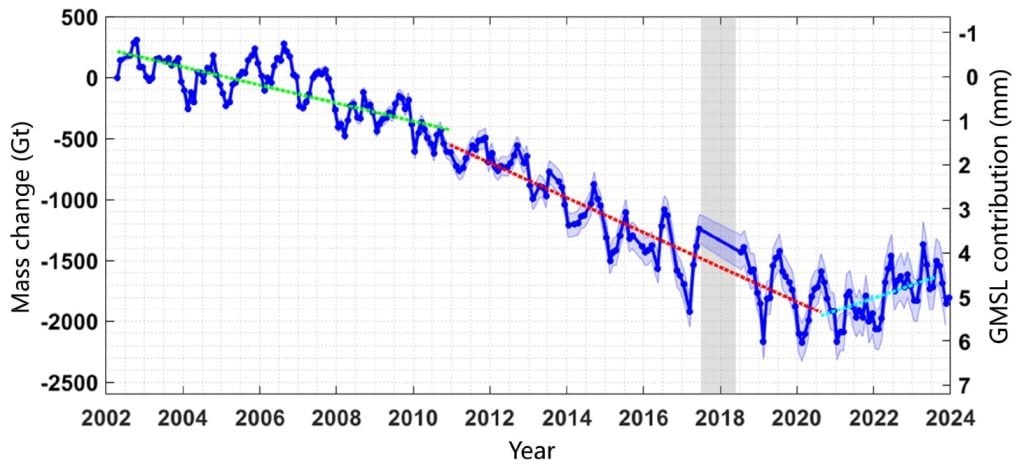For decades, Antarctica has been a symbol of global warming. Its melting ice sheets, calving glaciers, and shrinking sea ice have warned the world about a heating planet. So when new satellite data revealed that Antarctica actually gained ice between 2021 and 2023, it caught many by surprise. Could this be a turning point in the climate crisis? Scientists say no. Instead, they stress that this is a temporary anomaly, not a reversal of a dangerous trend.
The Satellite Data Behind the Discovery
The findings come from researchers at Shanghai’s Tongji University, who analyzed more than twenty years of satellite measurements collected by NASA’s Grace and Grace Follow-On missions. These satellites track tiny variations in Earth’s gravity field, allowing scientists to measure changes in ice mass with precision.
From 2002 to 2020, the picture was grim. Antarctica consistently lost ice, and the rate of loss accelerated over time. Between 2002 and 2010, the continent lost about 81 billion tons per year. By the following decade, from 2011 to 2020, that figure nearly doubled, reaching 157 billion tons annually.
Then something unusual happened. Between 2021 and 2023, Antarctica gained around 119 billion tons of ice per year. In eastern Antarctica, four major glaciers that had been shrinking rapidly showed significant growth. For a region so strongly associated with decline, this reversal was striking.
What Caused the Sudden Ice Gain?
Scientists quickly clarified that the growth had less to do with long-term trends and more to do with short-term weather. The main driver was an increase in snowfall, caused by unusual atmospheric conditions. Warmer air holds more moisture, which means that when the right conditions align, heavier snowfall events can occur—even in places known for ice loss.
Tom Slater, a researcher at the University of Northumbria who was not part of the study, explained it clearly: “The recent gain only partly offsets the long-term losses. Glaciers are still accelerating, and they continue to flow into a warming ocean.” In other words, the extra snowfall bought Antarctica a brief pause, but it does not erase decades of decline.
Why Monitoring Antarctica Matters
The Antarctic ice sheet is the largest on Earth, holding about 90% of the planet’s fresh water. Even small shifts in its mass can translate into measurable changes in global sea levels. That’s why scientists monitor the region so closely. What happens in Antarctica doesn’t stay there—it affects coastal communities worldwide.
While the Arctic has been warming dramatically, Antarctica has been somewhat more stable. But warning signs are growing. In 2023, Antarctic sea ice coverage hit record lows, raising alarms about the continent’s vulnerability in a warming world. These shifts suggest that Antarctica may be on the verge of more significant and possibly irreversible changes.
Temporary Gains Don’t Mean Global Cooling
So what does this short-lived ice gain really mean? Scientists stress that it does not contradict climate change. Earth’s climate is a complex system, where local or temporary variations are common. An increase in snowfall in one region over a short period does not cancel out the long-term warming trend observed globally.
In fact, the very conditions that produced more snowfall are linked to a warmer atmosphere. More moisture in the air increases the likelihood of extreme weather events, including heavy snow. This paradox highlights how climate change can create temporary anomalies that mask the larger trend of global heating.
The Bigger Picture: Ice Loss Still Dominates
When looking at Antarctica’s ice balance over decades, the conclusion remains clear: loss far outweighs gain. The temporary uptick in 2021–2023 does little to compensate for the billions of tons of ice that vanished in the years before. The long-term trajectory remains downward, and the consequences are serious—rising sea levels, disrupted weather patterns, and a less stable global climate.
The takeaway is simple but important: climate change is not linear. There will be fluctuations, pauses, and surprises along the way. But these should not be mistaken for reversals. The Antarctic ice sheet continues to shrink overall, and its future will shape the fate of coastlines and communities worldwide.
Conclusion: A Reminder, Not a Reprieve
The recent gain in Antarctic ice is a scientific curiosity, but not a climate victory. It reminds us that the Earth system is dynamic, influenced by shifting patterns of temperature, moisture, and circulation. Yet the broader picture remains sobering. Warming continues, seas are rising, and the ice that protects our planet is disappearing faster than it is being replaced.
For those hoping that Antarctica’s recent growth is a sign of climate change slowing, the message from scientists is clear: don’t be fooled. The planet is still warming, and the fight to protect our future remains as urgent as ever.

